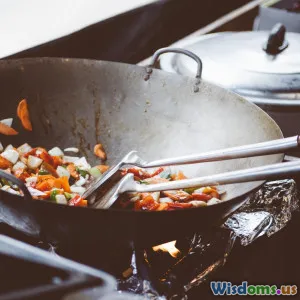
Five Mistakes When Storing Meal Prep Food Safely
9 min read Avoid common errors that compromise your meal prep's safety and taste with expert storage tips. (0 Reviews)
Five Mistakes When Storing Meal Prep Food Safely
Meal prepping is a game changer for anyone looking to save time, eat healthier, and maintain dietary discipline. You spend hours cooking, chopping, and portioning out your meals, expecting convenience and nutrition to last all week — but your efforts can be quickly undone by a critical aspect: storage.
Improperly storing meal prep food not only spoils the taste and texture but also invites harmful bacterial growth that can lead to foodborne illnesses. The good news? Avoiding common mistakes can make your meal prepping more effective and safe.
In this article, we’ll explore five of the most frequent errors people make when storing meal prep and share expert-approved methods for keeping your food fresh, nutritious, and safe to eat.
1. Ignoring Proper Cooling Before Refrigeration
Why it Matters
Hot food straight from the stove or oven should never go directly into the refrigerator. Many meal preppers, eager to store food quickly, slip into this error. However, packing warm meals into the fridge raises the internal temperature, potentially pushing other stored items into the 'danger zone' (40°F - 140°F or 4°C - 60°C) where bacteria multiply rapidly.
The Science Behind Cooling
According to the USDA, perishable foods shouldn't stay between 40°F and 140°F for more than two hours—or one hour if the ambient temperature is above 90°F. Placing hot food directly inside the fridge delays cooling, increasing risk.
Best Practice: Rapid Cooling
Allow cooked meals to cool to near room temperature within two hours. To speed up cooling, divide the food into smaller, shallow containers (no more than 2 inches deep). This maximizes surface exposure to the cooler air, enabling quicker temperature drop.
Example: Maria preps a large batch of chili. Instead of filling one big container, she splits the chili into four shallow containers for faster cooling, then refrigerates. Her meals keep fresh longer without food safety risks.
2. Using Incorrect Storage Containers
The Pitfalls of the Wrong Containers
Many opt for whatever container is handy, such as plastic bags or non-airtight containers. This leads to moisture loss, flavor degradation, and increased bacterial infiltration.
Leakage and contamination also become concerns with low-quality containers.
Choosing the Right Containers
- Airtight and Leakproof: Ensure your containers seal tightly to retain moisture and prevent cross-contamination.
- Material Safe for Storage: Glass or BPA-free plastic containers are ideal. Glass is non-porous and less likely to absorb odors.
- Microwave and Dishwasher Safe: Convenience enhances reheating and cleaning.
Practical Tip
Label containers with the date of preparation to track freshness effectively.
Data Insight: A 2017 study in the Journal of Food Science revealed that airtight storage significantly slows microbial growth on cut fruits and cooked meats compared to loosely covered or open storage.
3. Overstuffing the Fridge or Freezer
Why Overstuffing Hurts Food Quality
A common trap is to cram meals into the refrigerator or freezer to maximize space and save trips. However, this reduces air circulation, hampering consistent temperature control.
Cold spots and warm zones can develop, allowing some food items to spoil faster or freeze unevenly.
Advice for Optimal Storage
- Allow space between containers: Facilitates air circulation, promoting evenly chilled conditions.
- Do not block vents: Fridge fans circulate cold air; obstructing their airflow kills efficiency.
Fun Fact
According to Consumer Reports, refrigerators operate most efficiently at 37°F with plenty of space inside.
Suggestion: Plan your meal prep volume according to available fridge or freezer capacity to ensure your food stays safe.
4. Ignoring Food Combining Rules
The Dangers of Cross-Contamination
Often overlooked is how foods can affect each other during storage. For example, storing raw and cooked items together, or mixing strong-smelling foods with delicate ones, leads to cross-contamination or flavor transfer.
Rules to Remember
- Store raw meats, poultry, and seafood in sealed containers on the bottom shelves to prevent juices dripping on other foods.
- Separate aromatic foods (like onions or fish) from mild-flavored meals.
- Avoid placing vegetables with fruits; some fruits emit ethylene gas accelerating vegetable spoilage.
Real-World Insight
Hospital kitchens rigorously follow these protocols, reducing reservation of cross-contamination from pathogens such as Salmonella or E. coli.
For meal preppers: Apply similar diligence to prevent illnesses and preserve taste.
5. Not Using Proper Labeling and Storage Timelines
The Cost of Forgetfulness
Meal incoming into the fridge/freezer without labeling often results in food staying too long, leading to spoilage and potential health risks.
Know Your Storage Times
- Refrigerated cooked meals: Ideally consume within 3–4 days (Bope & Kellerman, 2017).
- Frozen leftovers: Consume usually within 2–6 months depending on food type — vegetables versus cooked meats.
Labeling Tips
- Record date cooked and contents on the container.
- Use waterproof markers or printed labels.
- Maintain a simple meal prep chart if you store multiple kinds.
Technology Boost
Apps like "FridgePal" or "FoodKeeper" help track expiry and recommend usage windows.
Example: John stores batches of chicken curry with dates prominently marked. This habit helped prevent food waste and kept his diet safe.
Conclusion
Meal prepping is not just about cooking in bulk—how you store your food impacts its taste, nutritional value, and most importantly, safety. Avoiding these five common storage mistakes ensures that each meal tastes as fresh and vibrant as when it was first prepared, saving money and protecting your health.
- Cool food properly before refrigeration.
- Use airtight, appropriate containers.
- Avoid overcrowding the fridge or freezer.
- Prevent cross-contamination by smart separation.
- Label and monitor storage times diligently.
Adopting these best practices transforms meal prepping from a routine chore into a successful lifestyle choice that nourishes your body and respects your efforts.
"Safe storage is the secret ingredient to successful meal prepping." — Food Safety Expert, Dr. Linda Hawkins
Embrace these expert insights today, and take your meal prep game to the next level!
References
- USDA Food Safety and Inspection Service: Basics for Food Safety, Chilling and Refrigeration Guidelines
- Bope & Kellerman (2017). Pathophysiology of Disease: An Introduction to Clinical Medicine, 7th Edition.
- Consumer Reports. "How to Organize Your Refrigerator." 2022.
- Journal of Food Science (2017). Effect of Packaging on Shelf Life of Cooked Meats.
Rate the Post
User Reviews
Popular Posts

















